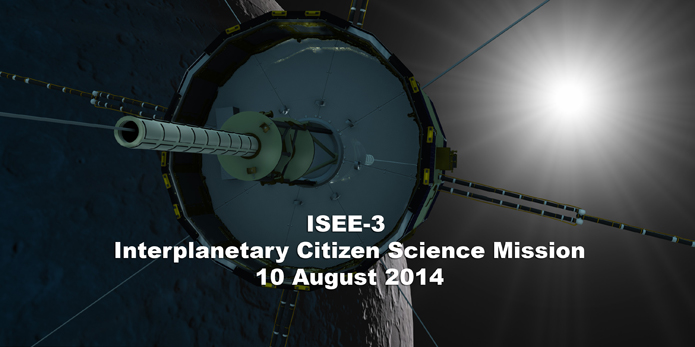
After a successful reawakening the venerable ISEE-3 spacecraft is about to begin the first interplanetary citizen science mission.
In April 2014 our team set about bringing the 36 year old ISEE-3 (International Sun Earth Explorer 3) spacecraft back into science operations. Our plan was to contact the spacecraft, evaluate its health, command it to resume normal operations, fire its engines, and resume the orbit it originally occupied in 1978. Once science operations resumed, our plan was to make the data openly available to citizen scientists – in fact, anyone, anywhere – as soon as we received it from the spacecraft.
This task required the ISEE-3 Reboot Team to recreate hardware, software, and documentation that had been discarded decades ago, reassemble it into a operational form, organize an international mission team of volunteer scientists and engineers, raise all of our own funds (privately) to do all this, and then implement a rescue and reboot attempt within a matter of weeks.
NASA gave us the green light and we successfully took command of ISEE-3 just 6 weeks after we began our project. We then brought its basic systems back online for the first time in decades. Shortly, the spacecraft will resume science operations with the half dozen science experiments that are still operational.
We have completely accomplished all of our original goals except for one: firing the ISEE-3 propulsion system in a sufficient fashion to alter its trajectory. We did operate the propulsion system briefly so as to correct the spin of the spacecraft, and to start the trajectory correction maneuver. The propulsion system works fine. The problem is that there is no longer any Nitrogen pressurant left in its tanks to allow it to work.
36 years and more than 30 billion miles have taken its toll on the spacecraft’s propulsion system. We have exhausted every option to bring the engines online so as to conduct the correction maneuver required to place it in its planned orbit. Without the pressurant it just won’t work.
While our original goal was to place ISEE-3 in a L-1 “halo” orbit, it will now do a flyby of the Moon and resume an orbit around the sun – an orbit nearly identical to Earth’s. We have begun the process of shutting down systems that are no longer needed and reconfiguring ISEE-3 to maximize science operations. We are also implementing plans that will allow us to listen to its science data no matter where it goes.
We will be beginning the “ISEE-3 Interplanetary Citizen Science Mission” on 10 August 2014 as the spacecraft flies by the Moon. We have a functional space craft that can do science and is already returning new data. All of our original citizen science objectives remain unchanged and are ready for implementation. In fact, we’ll be announcing some new partnerships shortly that will serve to turbocharge our efforts in this regard.
This will be the first citizen science, crowd funded, crowd sourced, interplanetary space science mission. A more detailed summary of recent activities and our partnership team will be posted at http://spacecollege.org/isee3
This project would not have been possible without the help of many people and organizations around the world. Most notably (a partial list) the alumni of the ISEE-3/ICE mission, NASA Solar System Exploration Research Virtual Institute, NASA Deep Space Network, Arecibo Observatory, AMSAT-DL, Bochum Observatory, SETI Institute, Kinetix, Ettus Research, Space Exploration Engineering, Applied Defense, Dirk Fisher Electronics, National Instruments, AR Research, SpaceRef Interactive, Skycorp Inc, Space College Foundation, Morehead State University, NASA Jet Propulsion Laboratory, Johns Hopkins Applied Physics Laboratory, NASA Goddard Spaceflight Center, NASA Science Mission Directorate, NASA Ames Research Center, NASA Headquarters, and the National Science Foundation.
We would also like to thank everyone we have not mentioned who has participated in phase one of this paradigm shifting project and look forward to many years of science data from a newly rebooted ISEE-3.
Most importantly we want to thank our 2,238 donors who invested $159,602 on our team’s crazy idea. Your spacecraft is now ready to “do science again”.
Dennis Wingo and Keith Cowing
Co-leads
ISEE-3 Reboot Project
For more information:
ISEE-3 Reboot Project website: http://spacecollege.org/isee3
Facebook: https://www.facebook.com/ISEE3Reboot
Google+: https://plus.google.com/110871408384252629393/
Twitter: http://twitter.com/isee3reboot